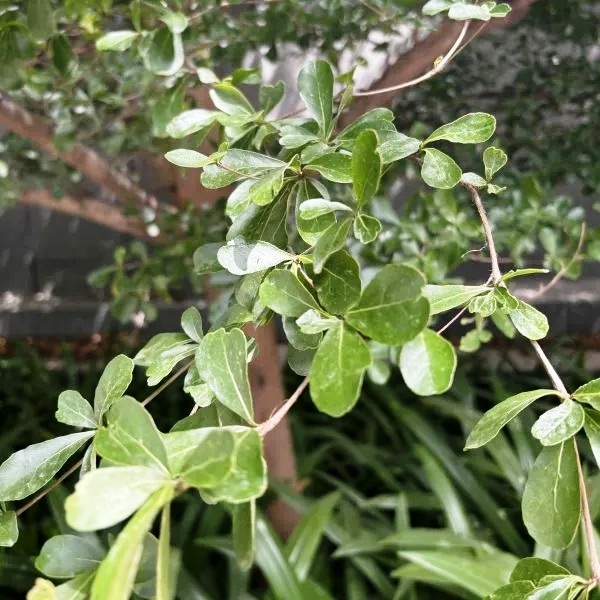|
Common Names: Madagascar Almond, Umbrella Tree, Pagoda
Tree
Local Names:
Species ID: NMP-249 | wfo-0000408827 | NCBI_Taxonomy ID:
578553
Scientific
Classification
Kingdom: Plantae
Clade: Tracheophytes
Clade: Angiosperms
Clade: Eudicots
Clade: Rosids
Order: Myrtales
Family: Combretaceae
Genus: Terminalia
Species: T. mantaly
Synonym: Terminalia neotaliala Capuron
Morphological Description
- Bark: Pale grey, smooth, mottled, often peeling in thin
flakes; used for its tannin content (Burkill, 1995).
- Leaves: Obovate to elliptic, 4–7 cm × 2–4 cm, bright
green when young, glossy; arranged in terminal rosettes of 4–9 unequal
leaves on short thickened petioles (Fern, 2024).
- Flowers: Small, creamy-white to yellowish (3–5 mm), in
axillary spikes; fragrant and attractive to pollinators (Prance &
Jongkind, 2015).
- Fruit: Ovoid drupes (1–2 cm), green turning
reddish-brown at maturity, containing a single seed; bird-dispersed (Fern,
2024).
- Native Range: Madagascar.
- Introduced Regions: Widely grown in Nigeria, Ghana, Cameroon,
Southeast Asia, Australia, and parts of the Americas (Kew Science, n.d.).
- Habitat: Lowland forest and river-banks, also urban
plantings; prefers well-drained loamy soils (pH ~5.5-7.0), 800-2,000 mm
annual rainfall, up to 1,500 m elevation (Fern, 2024).
- Ecological Role: Shade-tree, soil stabiliser, resistant to
termites; supports pollinators and seed dispersers (Burkill, 1995).
- Antimalarial: Leaf and stem-bark methanolic extracts inhibited
Plasmodium falciparum (IC50 2.09 µg/mL) and increased survival in P.
berghei-infected mice; attributed to flavonoids and ellagic acid
derivatives (Mbouna et al., 2018).
- Antifungal: Stem-bark methanolic extracts inhibited Candida
albicans (MIC 39 µg/mL) and C. parapsilosis (MIC 24 µg/mL), linked to
3,3′-di-O-methylellagic acid and arjunglucoside (Tchuenmogne et al.,
2017).
- Antibacterial/Nanoparticle
enhanced: Silver nanoparticles
synthesised from stem-bark extracts (TM-AgNPs) exhibited MIC 3.12 µg/mL
against Haemophilus influenzae – approx. 40× more potent than crude
extract (Majoumouo et al., 2019).
- Astringent/Gastrointestinal
support: Bark decoctions used for
dysentery and diarrhoea in Madagascar; tannin content supports astringent
and hemostatic effects (Burkill, 1985).
- Anti-inflammatory: Leaf poultices used traditionally to reduce
swelling.
⚠ Toxicity Profile: No mortality was observed in mice at methanolic
stem-bark extract doses up to 2,000 mg/kg. Sub-chronic (400 mg/kg for 28 days)
resulted in mild elevation of liver enzyme ALT (~10%). High doses (>1,000
mg/kg) may cause mild gastrointestinal discomfort. Data on pregnancy and
children are limited; heavy-metal contamination of wild-harvested materials is a
concern (Mbouna et al., 2018).
- Ornamental: Planted widely for its tiered, pagoda-like crown,
used for avenue and shade planting (Fern, 2024).
- Dyeing: Bark tannins used in Madagascar for dyeing
textiles shades of brown and black (Burkill, 1985).
- Reforestation/Agroforestry: Used to stabilise soils, support re-vegetation,
and provide termite-resistant wood (Fern, 2024).
- Cultural: In Malagasy tradition, tree planted near homes
for protection; though specific ritual documentation is limited (Burkill,
1985).
- Burkill, H. M.
(1995). The useful plants of West Tropical Africa (Vol. 3). Royal Botanic Gardens, Kew.
- Burkill, H. M.
(1985). The useful plants of West Tropical Africa (Vol. 1). Royal Botanic Gardens, Kew.
- Fern, K. (2024).
Terminalia mantaly. Useful Tropical Plants Database. Retrieved from
https://tropical.theferns.info/viewtropical.php?id=Terminalia+mantaly
- Kew Science. (n.d.).
Terminalia mantaly H. Perrier. Plants of the World Online. Retrieved from https://powo.science.kew.org/taxon/urn:lsid:ipni.org:names:171229-1
- Majoumouo MS, Sibuyi
NRS, Tincho MB, Mbekou M, Boyom FF, Meyer M. Enhanced Anti-Bacterial Activity
Of Biogenic Silver Nanoparticles Synthesized From Terminalia mantaly Extracts.
Int J Nanomedicine. 2019 Nov 19;14:9031-9046. doi: 10.2147/IJN.S223447. PMID:
31819417; PMCID: PMC6875292.
- Mbouna, C. D. J.,
Kouipou, R. M. T., Keumoe, R., Tchokouaha, L. R. Y., Fokou, P. V. T., &
Boyom, F. F. (2018). Potent antiplasmodial extracts and fractions from
Terminalia mantaly and Terminalia superba. Malaria Journal, 17(1), 142.
- Prance, G. T., &
Jongkind, C. C. H. (2015). Combretaceae. In Flora of West Tropical
Africa. Royal Botanic Gardens,
Kew.
- Tchuenmogne, M. A. T.,
Kammalac, T. N., Gohlke, S., Kouipou, R. M. T., Aslan, A., Kuzu, M., … &
Boyom, F. F. (2017). Compounds from Terminalia mantaly L. (Combretaceae) stem
bark exhibit potent inhibition against some pathogenic yeasts and enzymes of
metabolic significance. Medicines, 4(1), 6.
|
